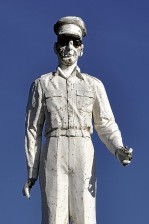‘What’s so important about MacArthur’s landing?’

Gen. Douglas MacArthur’s statue in Dagupan City is left at the mercy of the elements and vandals. WILLIE LOMIBAO / CONTRIBUTOR
Sixty-eight years after American Gen. Douglas MacArthur and the Allied Forces landed on Jan. 9, 1945, on the shores of the Lingayen Gulf in Pangasinan to liberate the Philippines from the Japanese, the exact spot where he first set foot is still the subject of discussions in the province.
And this time, it’s on Facebook.
The debate began when this correspondent posted an image of a page from the book, “Australia in the War of 1939–1945, Volume II – Royal Australian Navy, 1942–1945 (1st Edition, 1968),” that said MacArthur first went ashore on the beaches of San Fabian town, north of Dagupan City.
The book, the second of two Navy volumes in the Australian official history of the 1939–1945 war, was written by Australian naval historian and journalist George Hermon Gill.
A chapter in Gill’s book described in detail how the Allied Forces had shot down Japanese planes and bombed enemy positions along the shorelines of Lingayen Gulf stretching from San Fernando, La Union in the east to Sual, Pangasinan in the west.
Article continues after this advertisementGill said MacArthur went ashore more than four hours after the first assault waves landed on the beaches of San Fabian and Lingayen about 9:30 a.m. on Jan. 9, 1945.
Article continues after this advertisementGill wrote: “On shore, progress was rapid against little opposition. The only enemy resistance encountered was on the extreme left flank. Just after 2 p.m., General MacArthur, with members of his staff, went on shore at San Fabian beaches, where they remained for three hours or so.”
But local blogger Simon Francis Blaise Vistro posted an e-mail from James W. Zobel of the MacArthur Memorial in Virginia that said MacArthur landed “just south of San Fabian in the 6th Division area of Blue Beach. After a few days he shifted his headquarters from the USS Boise to Dagupan.”
Pangasinan poet Santiago Villafania said “south of San Fabian” could still be within San Fabian town and it could just have been south of the poblacion (town center), which is the reference point.
Virginia Jasmin Pasalo, a commissioner of the Pangasinan Historical and Cultural Commission, said she had known that MacArthur first landed in San Fabian because she read it in documents kept by the Firestone Library in Princeton University, where she studied.
“However, what’s so important about his landing? In one of the documents I read, the Americans did not discriminate whether they killed Filipinos or Japanese, they cleared the whole town of San Fabian of inhabitants, including children,” Pasalo said.
“It was not a battle for Filipinos, it was a battle for territory between Japanese and Americans and we got caught in between. We felt liberated from the oppression inflicted by the Japanese and did not have time to feel and reflect on the American assault that resulted in quick death in towns where perceived Japanese were located. So what if he landed his right foot, left foot and both feet and stayed in San Fabian for three hours? Even Americans do not understand the ‘holiness’ by which we regard his landing as the second coming of Jesus Christ,” she said.
San Fabian resident Natalia Basto-Dalaten said her late grandmother told her that she was hit by a shrapnel before MacArthur landed in San Fabian.
“Her right leg was amputated and one of my uncles died in that incident. My grandmother who lived in Sobol, a coastal village in San Fabian, was right in claiming that MacArthur first landed in San Fabian,” Dalaten said.
In 2011, in what was to be his last public appearance, former Agrarian Reform Minister Conrado Estrella Sr., who also served as Pangasinan governor, said MacArthur had told him during a visit to Lingayen in 1961 that he landed at the back of the provincial capitol, just a few meters away from Urduja House (the official residence of the governor).